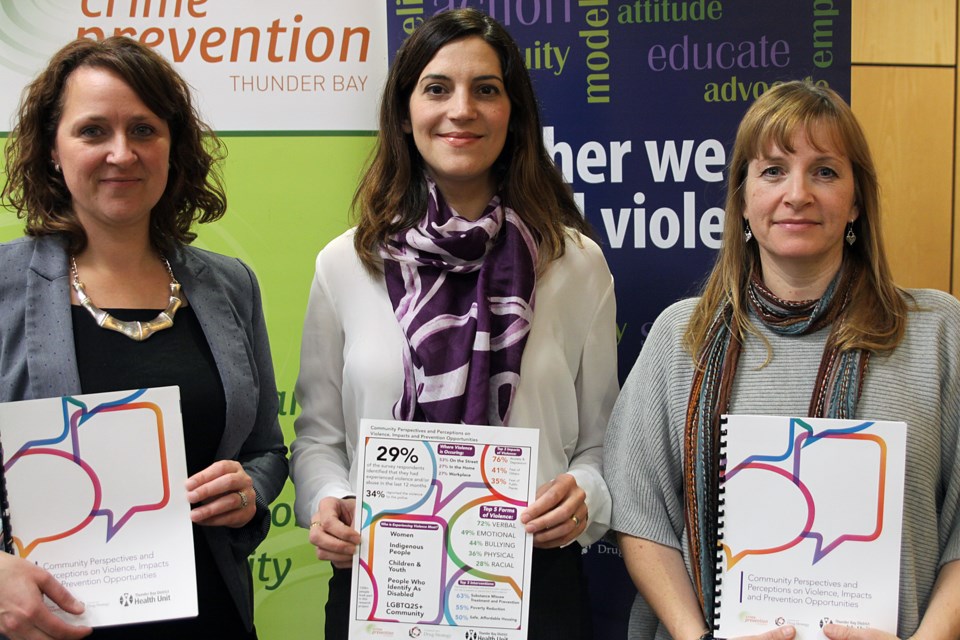THUNDER BAY – Nearly half of Indigenous respondents to a study collecting data on perceptions of violence in Thunder Bay reported experiencing some form of victimization in the previous 12 months.
Findings from the Community Perspectives and Perceptions on Violence, Impacts and Prevention Opportunities report, released on Thursday, found that 29 per cent of the nearly 1,200 respondents to an online survey acknowledged being subjected to violence or abuse.
Individuals who self-identified as Indigenous, having a disability or being a member of the LGBTQ2S were at a higher risk of being targeted by violence, with more than 40 per cent of respondents from each demographic reporting experiencing violence. Indigenous respondents had the highest rate at 48 per cent.
Thunder Bay Crime Prevention Council coordinator Lee-Ann Chevrette said while the statistics of the study aren’t as reflective as other data such as police’s annual crime data or Statistics Canada’s crime severity index, it allows the voices of those who have experienced violence to be heard.
“There’s no one single solution to violence in our community. There’s no one single cause,” Chevrette said. “This is a really complex issue. Having engaged these individuals in our community in a conversation, I think is a really important first step because we need a community approach to addressing the harms related to violence in our community.”
The report, which was a joint initiative between the crime prevention council, Thunder Bay Drug Strategy and Thunder Bay District Health Unit, included the online survey as well as stakeholder interviews and community focus groups representing seniors, youth, service organizations, homeless individuals, the LGBTQ2S+ community, persons with disabilities, women, Indigenous and other cultural minority groups. The survey was available for nearly a month last year.
Only 34 per cent of people said they reported their incidences of violence to police. For Indigenous participants, 45 per cent said they didn’t want to involve the police with the same amount reporting no physical injury. Nearly 42 per cent reported having a previous negative experience with police and 36 per cent said they had reported a previous incident without receiving their desired outcome.
“Ultimately we want to be increasing reporting rates so those rates are known and people are accessing the supports that are required, and that the supports that are required are available at the levels that reflect the reality of the experience of violence in the community,” Chevrette said.
The study asked participants to identify the forms of violence they experienced. Verbal violence or abuse was encountered most frequently at 72 per cent, with emotional abuse being reported by 49 per cent. Physical violence was reported by 36 per cent.
For Indigenous respondents, 76 per cent experienced verbal violence or abuse while 52 per cent reported being subjected to racial violence or abuse.
“When most people think about violence it’s about physical harm. I think it’s really important to broaden the perspective and understand there are a lot of diverse forms of harm or violence in our community,” Chevrette said.
“The psychological harm associated with being bullied or being verbally assaulted, these are really important harms and this is violence in our community.”
Women reported being twice as likely to have experienced physical violence, at 76 per cent compared to 41 per cent for men. As well, more than a quarter of those who had experienced any form of violence said it occurred in their home.
“We focused on the physical violence, the bullying, the racism, but domestic violence still came through loud and clear. We know that 27 per cent of that violence was happening in the homes,” Thunder Bay District Health Unit public health nurse Rosemary Scofich said.
Scofich said another 27 per cent was reported on the job, but the study didn’t ask whether it was co-workers or from members of the public attending the victims’ workplace.
“Some of the issues were addressing those social determinants of health. If people are experiencing poverty and homelessness, food insecurity, it makes people more vulnerable to experiencing violence and at times to perpetrating violence because the needs are so great.”
